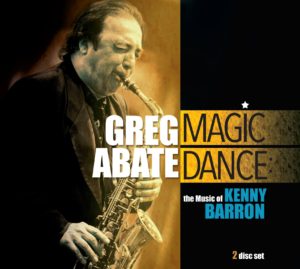 The new double disc album from Greg Abate finds the Rhode Island saxophonist playing tribute to the music of Kenny Barron. Not only does Abate arrange and play Barron’s compositions here, he has Barron featured on piano as part of the band that has recorded this work Magic Dance: The Music Of Kenny Barron.
The new double disc album from Greg Abate finds the Rhode Island saxophonist playing tribute to the music of Kenny Barron. Not only does Abate arrange and play Barron’s compositions here, he has Barron featured on piano as part of the band that has recorded this work Magic Dance: The Music Of Kenny Barron.
Opening track “Sunshower” finds Abate blowing a light, mellifluous sax line, an interval of notes that feel like an invitation to a conversation. Soon, Abate and his band mates are engaged in a lively give and take. His racing saxophone line meets up with Barron’s sultry piano expression, a line of notes that ripple with urgency. The melodic lines nudge bassist Dezron Douglas to press out some quick nimble low end while drummer Johnathan Blake drums up a mini solo that feels melodic in its flow of percussion. It’s the multitude of notes that the band pushes by each other toward further inspiration that makes this piece work.
“Cook’s Bay” is a piano players joy ride. Barron’s notes, lively and free, remind of birds moving through the sky. Abate plays off this with a sax line that enjoys the wide open space created by Barron. Abate fills the space with a jumpy line that engages with its sudden ups and downs in movements. Switching to flute while also playing his sax makes for a mellow close out by returning to the initial mood of this piece.
“Golden Lotus” sweeps in with a wide, breathless saxophone line then swiftly switches to thinner lines, lines supported by mildly played, brief bits of piano. The circular intervals of sax and piano mirror each other with contrasting dynamics, creating a fine tapestry of sound. Increasing dynamics and tempos makes this piece into a more driving force until it segues into a middle ground of tension. These shifts from one fine way of presenting the themes to another makes for some entertaining music as the listener needs to improv along with the band and its array of idea.
Abate makes the most of overdubbing multiple horn parts on this album. A good example of this is “Innocence” which features many different saxophones in their different ranges playing as a horn section, blowing a warm, thick wall of music. When the horns give way to piano and a singular soprano sax, the contrast is astounding, letting the thinner horn dance in circles and spirals over pleasant thumps of piano, bass, and drums. Most of “Innocence” plays with mood, something halting in the instrumentalists’ presentation gives a darker tone. This works well to keep the listener intrigued to see what other feelings this piece might evolve into.
Piano notes fall like rain drops on “Water Lily,” a pretty, down tempo affair that requires Abate to relinquish saxophones for flute. His airy flute notes make a perfect waltz with the Barron piano tinkling, a line inspired more by feeling than structured in a pre-planned manner. The lightness with which each of these four players play is astounding. They keep one so engaged by their whispery framework that inspires one to listen more closely to learn how this breezy works comes together.
“Sonia Braga” is a slow, hipster jazz glide. Abate plays an engagingly thin and slippery sax line. It dances around an oldies groove, a groove from the late 1940s to early 1950s era of jazz, when hip cat daddios were following this kind of music in the decades just before rock and roll. Barron’s low key ivory tinkling creates a coffeehouse vibe with their soulful notes. Douglas, nudging the tune forward with chunky bass notes, injects his own purposeful cool. Everything here comes together with a low key gel, a loose feeling that never loses the vibe of being in a cozy jazz piano bar..
“Bud Like” is a frenzied pace tune. Abate’s thin slices of mad saxophone dance around a classy piano flavored groove. As Abate goes to town, moving his sax line like a hot rod chasing through city streets, Barron supports with a pumping sensation. Eventually, Barron goes to town with a more adventurous line as Abate supports with a more muted one. The restless musicianship pays off as the unfettered sax line keeps the listener on his toes wondering if it will be able to unfurl to a graceful end. It does, matching Barron’s undaunted piano dash
“Lemuria” may be termed the “acid jazz” track in this album. Its opening, hailed by speedy drums, brisk piano playing, soon turns into a cleverly fast Abate sax quest. Abate plays an edge of your seat listening experience for his fans by making his melodic line zip around like nobody’s business, intervals of notes, dynamics, tempos all changing so swiftly they seem to become one. Like a friendly child in this playground, Abate graciously lets Barron have his own turn. Barron slaps out a wide, assertive piano line before Blake plays a solo loaded with numerous, swift notes from the drum kit. Maintaining their paces while dabbling along the way in clever techniques makes this piece a fun ride for the listener.
“Concentric Circles” peppers the listener with bits of flinty notes from the rhythm section instruments while Abate plays a whistle thin melody that contrasts brilliantly with what is playing out beneath him. His moody, sorrowful sax melody kisses the ear with its gentle, forlorn tone. It also rides smoothly over Barron’s persistent piano groove, chords and notes that push things along, supported by just enough assertion from the bass and drums, which too are noteworthy for their plethora of notes within their sensitive approach. This piece works as a study in contrasts and in how to create multiple motions within a single piece.
Of this combo’s strengths is its ability to convey a mood. Barron unfurls true beauty on “Rain,” a piano lead piece that carries the listener along with its unobtrusive tuft of tender notes and delicate feeling. This sets the scene for Abate to chime in with a low key sax line. Abate’s line, too, carries a good amount of the emotive weight of this piece, a listener’s paradise that inspires a person to quietly lounge while sipping a favorite beverage.
“Voyage” Blake ushers us into “Voyage” with a plethora of solo drum notes. Those busy drums become the platform for this very busy piece. As Blake keeps the beat beating and repeating and recycling into a wider pattern, the upper register instruments get busier still. Abate’s frenetic sax work and Barron’s racing piano notes and chords go wild, creating a wide, recreational feel, and one can image a free for all party on board a cruise ship or inside a swanky hotel function room. This one dazzles with its energy and how each player works off each other. Douglas briefly takes over with thick low end notes that move in chunky waves to add another layer of lively panache.
Title track “Magic Dance” is a sprightly number. Abate’s sax line moves in multiple directions. It feels upward, then downward, then further downward while moving side to side. His melody reminds of something moving magically through the air as if with a mind of its own. Barron’s soothing piano chords dart through this piece with a similar aplomb, feeling as if they can go in any direction at once. It is that busy, unanchored feeling that makes this whole thing work. Architecture from another dimension might be the best description.
“Song For Abdullah” finds the combo taking things low key. A breezy sax melody augmented by gentle piano tinkling creates a soothing vibe. Adie from an important rest between two busier pieces, this number establishes this combo’s ability to set a mood. Many activities, leisure, romance, travel could take place to this soundtrack as it is as deep as it is quiet, Intervals in the sax line can stir the imagination as they are intricate and tastefully self-restrained.
Close out track “And Then Again” is busier than an intercity highway. An assortment of horns blow coolly over a fun, thumping rhythm section. The contrast between a freewheeling sax and the brisk groove highlights the strengths of each. The horn’s melodic line is like a siren call to party. Jumpy piano, bass, and drums conjure images of many people coming through the dancehall doors and then cutting a rug on the dance floor. Quick notes from piano, bass, and drums make for a second contrast, the looseness of the horn and the controlled energy of the support players.
Greg Abate has done it again. Abate has taken another fine idea and turned it into a fun and impressive jazz outing. Recording the compositions of Kenny Barron while featuring Barron on piano resulted in this double disc extravaganza, Magic Dance. Lasting almost 90 minutes, Magic Dance was produced by Abate and Neil Weiss at Van Gelder Studio in Englewood Cliffs, New Jersey.

